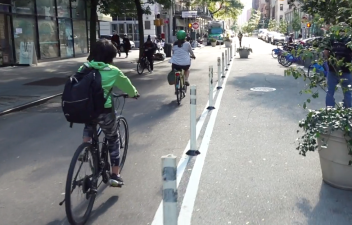Wiki Wednesday: Bike Boulevards
The inclusion of $825 million for Transportation Enhancements in the stimulus package should help pay for a lot of bike projects. Writing for Citiwire this week, transportation analyst Sam Seskin suggests investing a chunk of that stimulus money in bicycle boulevards, as opposed to bike lanes or cycle tracks. What are bike boulevards? This week’s StreetsWiki entry explains:
Bicycle boulevards are lightly-trafficked streets that prioritize bicycles. Although many routes have
no bike lanes, bicyclists are free to use the middle of the street,
sharing road space with cars. Motorists on these routes expect to see
bicyclists and therefore travel with caution. Designated streets should
be distinguished with uniformly colored signs and bold pavement
markings.For novices or younger riders, bicycle boulevards
provide a transition between bike paths and high-traffic shared roads.
But they are also quite useful for experienced riders because of their
reduced traffic and connectivity.The cost of implementing a bicycle boulevard network is significantly less than constructing bike paths or trails.
In Portland and Berkeley, transportation planners have created bike boulevard conditions by diverting automobile through-traffic and slowing down the cars that remain. The resulting bike-friendly corridors are a key component of Portland’s strategy to increase bicycle mode share and expand the appeal of cycling beyond the "young and fearless" demographic.

